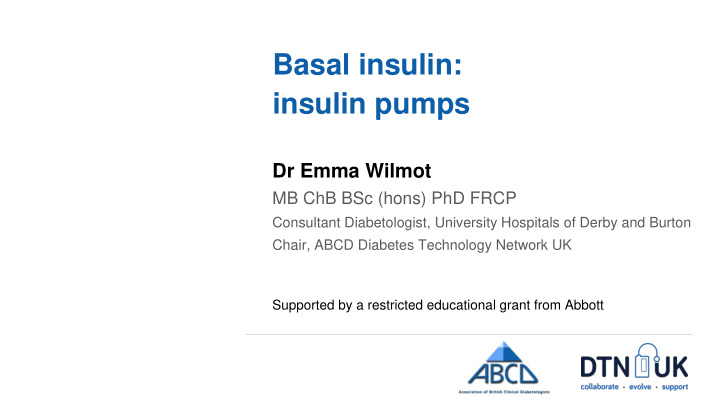



Basal insulin: insulin pumps Dr Emma Wilmot MB ChB BSc (hons) PhD FRCP Consultant Diabetologist, University Hospitals of Derby and Burton Chair, ABCD Diabetes Technology Network UK Supported by a restricted educational grant from Abbott
Dr Emma Wilmot • Chair, Diabetes Technology Network UK • Consultant Diabetologist, University Hospitals of Derby and Burton, England UK • Honorary Assistant Professor (consultant), University of Nottingham • DAFNE Executive board member Disclosures: Personal fees and educational grants from: Diabetes Care, Boehringer Ingelheim, Dexcom, Diasend, Eli Lilly, Medtronic, Novo Nordisk, Roche, Sanofi Aventis.
Learning objectives • Understand the desired effect of basal insulin on glucose levels • Feel more confident adjusting basal insulin in response to FreeStyle Libre traces • Understand which factors change insulin requirements
Insulin Pump Basal Insulin • The role of basal insulin is to keep glucose steady when not eating and to provide 24 hour coverage • On an insulin pump the basal rate can be set hour to hour meet the needs of the individual throughout the day • Many need higher basal rates in the morning and lower rates later in the day
Insulin Pump Basal Insulin • Blood insulin levels reach a steady state 2-5 hours after a basal rate change https://abcd.care/dtn-uk-best-practice-guides
Assessing basal insulin
Pump basal rate testing • The FreeStyle Libre helps with basal rate testing by providing 24/7 insight into glucose levels • Basal rates are best assessed on ‘normal days’ • Many factors can change insulin requirements: stress, alcohol, illness, exercise etc.
Basal insulin dose correct • To assess whether the basal rate is correct, look at the glucose trace overnight • If the basal rate is correct, the glucose level should stay stable overnight
Basal insulin rate too low • If the basal rate is too low, the glucose will rise • A recurrent rise in glucose overnight can mean the basal rate needs to be increased
Increasing the basal • Identify when the glucose starts to rise and increase the basal rate 2 hours before this • This person has noticed a recurrent rise in their glucose from 3am-7am • They should increase their basal from 1am-5am
Basal insulin rate too high • If the basal insulin dose is too high, the glucose will fall overnight • A recurrent fall in glucose overnight can mean the basal rate needs to be decreased , usually 2 hours before the fall begins
Reducing the basal • Identify when the glucose starts to fall and reduce the basal rate 2 hours before this • This person has noticed a recurrent fall in their glucose from 3am-6am • They should decrease their basal rate from 1am-4am
Dawn Phenomenon • Glucose can increase in the morning before waking - the Dawn Phenomenon
Dawn Phenomenon • Identify when the glucose starts to rise and increase the basal rate 2 hours before this • This person has noticed a recurrent rise in their glucose around 3-7am • They should increase their basal rate from 1am-5am
High morning glucose? • A high, flat glucose overnight is often not a sign that the basal insulin is a problem • Snacking in the evening is a common cause • Aim for an in target glucose pre-bed
Daytime basal rate testing • You can check the basal rate during the day by skipping a meal and observing the FreeStyle Libre trace • This morning basal rate test shows the basal insulin settings are correct, followed by lunch at 12pm • If the basal rate is correct, the glucose should remain steady
Basal control • This is ideal • Reality is insulin requirements vary greatly overnight • This trace is not possible every night for the vast majority of people living with Type 1 diabetes
Basal insulin: cruising at the desired altitude
Turbulence in basal requirements Exercise, standing, alcohol, relaxation Stress, illness, sitting, pre-menstruation
What would you do with the basal overnight?
Question What would you do with the basal insulin? 1. Increase 2. Decrease 3. Stay the same
Alcohol Alcohol Question What would you do with the basal insulin? 1. Increase 2. Decrease 3. Stay the same When in target pre bed basal is perfect
Alcohol Alcohol Question What would you do with the basal insulin? 1. Increase 2. Decrease 3. Stay the same When in target pre bed basal is perfect
Hypoglycaemia • If an unexplained night-time hypos occurs, reduce the overnight basal rate immediately the following night • More information on hypoglycaemia can be found in Dr Pratik Choudhary’s Hypoglycaemia module
Conclusion • FreeStyle Libre allows you to see your glucose trend overnight • The aim of basal insulin is to keep the glucose stable overnight, most nights • There are factors other than insulin which can send the overnight glucose up and down
Recommend
More recommend